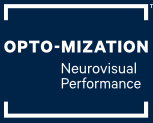Post Trauma Vision Syndrome
Post Trauma Vision Syndrome is very common after a concussion or head injury.
Click on the button to learn more.
Patient Version
As you are reading this text, your brain is controlling how the incoming information is processed, and how your eyes track, coordinate, and focus. Post Trauma Vision Syndrome refers to deficits in these areas after a concussion, head injury, whiplash, or mild traumatic brain injury (MTBI). If you have PTVS and your eyes do not work together efficiently, you will have a hard time sustaining your attention and may even end up with a headache or migraine.
Problems with inaccurate eye tracking may cause you to mix up the information, or feel like you struggle to comprehend it. It has been common to think about “vision” as just seeing clearly and the physiological health of the eye itself, with almost no attention given to how accurately or efficiently the system works.
The paradigm is now shifting as we understand the importance of the neurological role in eye coordination and information processing, which parallels the changes in vestibular (inner ear) understanding during the last few decades. With over 50 percent of the brain involved in visual function, PTVS is commonly responsible for ongoing symptoms after trauma.

What is Post Trauma Vision Syndrome?
Post Trauma Vision Syndrome is caused by damage to regions of the brain that are involved in various aspects of visual function. This disrupts the stored “programs” for how the visual system functions.
This damage occurs on the axonal level and often escapes detection by medical imaging. PTVS encompasses more specific diagnoses like egocentric visual midline shift, oculomotor dysfunction, binocular dysfunction and more.
What are the effects of Post Trauma Vision Syndrome?
Post Trauma Vision Syndrome may affect one or more specific areas of visual function, so the effects can be varied. PTVS can affect one’s ability to read, comprehend, and sustain attention. It can also cause dizziness/vertigo and headaches/migraines.
Reading
If you were a marathon runner who sustained an injury that disrupted the coordination of your legs, it would be understandable as to why your running was suffering even if you were physically healthy and in great shape. It would also be understandable as to why you would not be able to run for as long as before.
When PTVS causes problems with eye tracking and how the eyes are working together it will impact a person’s reading abilities and how long they can sustain the process. If it becomes difficult to control eye coordination, the reading comprehension will also drop.
This challenge is similar to how hard it is to hold a conversation when you are learning to drive a manual transmission, as all your conscious ability is directed towards just trying to do it. Vision dysfunctions that affect reading can also indirectly affect any other testing involving reading.

Dizziness/balance/vertigo
Vestibular, proprioceptive (information from muscles and joints), and visual information all need to accurately integrate together. PTVS causes the visual system to feed “garbage” into this collaboration, which will prevent proper integration often causing the person to plateau with vestibular rehabilitation.
Unfortunately, this has led to accusations of malingering when there was truly an unidentified vision problem preventing rehabilitation. Often in an assessment, there are lenses (glasses) that can be put on a person that changes their perception of physical space, dramatically improving their balance and symptoms immediately.
It is also possible to mimic some of these problems in someone who has a normal visual function by reversing the process.
Headaches/Migraines
Vision dysfunction after an injury can result in a litany of headaches and migraines often associated with computers, reading, busy visual environments, and other visual stimuli.
Using a high-contrast black-and-white grid and gauging the person’s reaction to it, is a great way to determine whether the visual system is playing a role in these symptoms.
Inefficiencies with how the eyes coordinate will produce situations that make it difficult for a person to sustain attention, which creates a confounding variable for a lot of testing.
Other Areas
PTVS can also cause difficulties with tracking moving objects and make stationary objects appear to move. It can create general fogginess, difficulty concentrating on tasks such as conversation (as the brain is using most of its resources on vision), light sensitivity, and even sensitivity to sound. It is as though most of the brain’s processing power is caught up in trying to make sense of the visual information, so there is less to allocate to other areas of function.
How is Post Trauma Vision Syndrome treated?
Similar to vestibular problems after a concussion, PTVS requires rehabilitative efforts centered around re-establishing the areas of affected visual function. Particular types of prescription lenses can improve the efficiency of visual function and how an individual processes depth and space. Treatment time can range from weeks to more than a year, and the neurological changes are permanent. Treatment for PTVS is commonly coordinated with other professionals.
Most eye examinations concentrate on acuity and the physical health of the eye. It is important that you ask your eye care professional if they can test for Post Trauma Vision Syndrome and the specific areas of visual function commonly affected.
Dr. Cameron McCrodan, OD, FCOVD
Board-certified in vision therapy and vision development.
Professional Version
Post Trauma Vision Syndrome (PTVS) is the most common visual sequel of mild Traumatic Brain Injury (mTBI)1. While termed mild, the symptoms and impact on life can be anything but. MTBI includes concussions, minor head trauma, minor head injury, whiplash, and more. Frustratingly, our current limitations in imaging most often mean that nothing is seen on a CT Scan or MRI2. Unresolved post trauma vision syndrome will significantly impede the therapeutic processes provided by occupational therapists and physical therapists.
PTVS is a constellation of signs and symptoms that may include2:
Conditions:
- Problems with the focusing mechanism (accommodation)
- Tracking (ocular motor function)
- Delayed visual memory/processing
- Convergence (how the eyes come together),
- Visual spatial distortions (visual-vestibular) along with associated neuro-motor (visual-motor output) deficits.
Common Symptoms2:
- Poor balance
- Headaches/migraines
- Inability to concentrate (reading/computer or even conversation)
- Dizziness/nausea
- Inability to tolerate crowded or busy places
- Disorientation
- Fatigue
- Delayed visual memory
Many of these symptoms are seen in Post Concussion Syndrome.
Condition Specifics:
Ocular motor dysfunction (saccade or pursuit dysfunction)
Ocular motor dysfunction (oculomotor dysfunction) refers to inaccurate tracking of the eyes. This can happen at a level of being unable to track from finger to finger, or being unable to track accurately through targets on a page. ‘Although there may be full ocular movements and no limitations in gaze, there may still be significant impairment to optimal ocular motor function regarding accuracy and speed of eye movements.’2 Accurate reaching (eye-hand), navigating through space, and reading require speed and accuracy of eye movements, and will be compromised if ocular motor dysfunction persists.3,4-8 Unresolved ocular motor disturbance will significantly impeded the therapeutic processes provided by both occupational and physical therapists.2
Binocular dysfunction
Problems with binocular vision are common secondary to ABI2,9-13. Binocular dysfunction refers to an inability to accurately use the two eyes together. There are varying levels, and many cases will pass ‘routine’ eye testing. They can be severely disabling to a person’s ability and performance in many activities of daily living2. Some of the affected areas include posture, balance, ability to move through space, reading, driving, playing sports. Binocular dysfunction can cause many negative symptoms such as headaches, dizziness and inability to sustain focus. Unresolved binocular disturbances will also significantly impede the therapeutic process of both occupational and physical therapists. 2
Convergence Insufficiency
Convergence Insufficiency means that there is an inability to appropriately use the eyes together at near. This may mean a complete inability to converge, or an inability to sustain convergence through standardized stress tests (base out prism). Convergence Insufficiency will impact ability of all tasks at near2. Common symptoms may include but are not limited to: words running together or blurring while reading, double vision, headaches, falling asleep when reading, reduced reading comprehension.2
Convergence Excess
Convergence Excess means that the eyes cross over each other too much when doing a near task. This can cause many symptoms such as headaches, dizziness, nausea, reduced reading speed/comprehension and more.
Visual Midline Shift
A visual midline shift represents a problem with egocentric localization2. This relates to a poor visual understanding of where objects in space are relative to ones self. Most simply put, an inaccurate understanding of where straight ahead is.14-16 Symptoms can include veering when walking, inaccurate hand-eye coordination and more.
Visual Vestibular Mismatch
Central vestibular processing relies on input from the visual system. If the visual system is not accurately processing movement and spatial information, the information it gives the vestibular system will result in vestibular type symptoms. The visual conditions will impede vestibular rehabilitation therapy because the visual system will continue to interfere. Symptoms can include dizziness, nausea and balance problems.
Accommodative Dysfunction
Insufficiency of accommodation is common after brain injury, even with young people9, 17 It refers to the inability or inaccuracy of the brain to control where the lens of the eye is focused, or the inability to accurately change the focus of the lens within normal ranges. Symptoms can include things such as blurred print, difficulty reading, and headaches.
What is Neuro-optometry
Adapted from: Suter PS, Harvey LH. Vision Rehabilitation: Multidisciplinary Care of the Patient Following Brain Injury. Boca Raton, FL: CRC Press, in press.
Neuro-optometrist
The neuro-optometrist is an optometrist who has special training in the neurological aspects of the visual system. The neuro-optometrist not only diagnoses general eye health problems and corrects refractive errors to improve visual acuity but also carefully assess functional binocularity, spatial vision, and visual processing abilities. Neuro-optometrists diagnose injury-related gross ocular and perception impairments, provide education regarding functional implications of visual diagnoses, and recommend treatment and compensatory strategies to speed rehabilitation. Treatment often includes prescription of specialty lenses and prism for improved performance in rehabilitation activities and reduced symptoms in daily living. Many neuro-optometrists work with trained vision therapists in their office to implement in-house vision rehabilitation therapy programs. In addition, some specialize in low vision, and intervene when low vision aids are needed secondary to reduced central vision, blindness, or cortical visual impairment that does not resolve with therapy.
Please note that at our clinic, we refer all ocular health exams to general practice optometrists or ophthalmologists. This allows us to spend our time where it is of best service to our patients.
Treatment
Vision rehabilitation/therapy
Vision rehabilitation was commonly thought of as helping patients with low vision (poor ability to see clearly) with devices and accommodations. It is now being defined as rehabilitating the pathways in the brain responsible for how the eyes track, work together, and how the brain uses the visual information for depth/space and vestibular integration.2 Vision rehabilitation allows for the previous conditions to be addressed in ways that improve function and reduce symtoms.2 There is a wide variety of ‘vision rehabilitation’ or ‘vision therapy’ that is offered, and the discerning practitioner is recommended to ask individual practitioners about their approach, success rates, and references.
Dr. Cameron McCrodan, OD, FCOVD
Board certified in vision therapy and vision development.
A large amount of the information adapted from: Suter PS, Harvey LH. Vision Rehabilitation: Multidisciplinary Care of the Patient Following Brain Injury. Boca Raton, FL: CRC Press, in press.
References:
- O’Dell, M.W., Bell, K. R., & Sandel, M. E. (1998). 1998 Study guide: brain injury rehabilitation, pain rehabilitation. Supplement to Archives of Physical Medicine and Rehabilitation.
- Suter PS, Harvey LH. Vision Rehabilitation: Multidisciplinary Care of the Patient Following Brain Injury. Boca Raton, FL: CRC Press, in press.
- Deng SY, Goldberg ME, Segraves MA, Ungerleider LG, Mishkin M (1986) The effect of unilateral ablation of the frontal eye fields on saccadic performance in the monkey. In: Keller EL, Zee DS, editors. pp. 201–208.
- Sharp, J.L. (1986) Adaptation to frontal love lesions. In E.L. Keller & D. S. Zee (Eds.), Adaptive processes in visual and oculomotor systems (pp.239-246). Oxford, UK: Pergamon Press.
- Xollin N.G. Cowey, A., Latto, R., & Marzi, C. (1982). The role of frontal eye fields and superior colliculi in visual search and non-visual search in rhesus monkeys. Behavioural Brain Research, 4(2), 177-193.
- Guitton, D., Buchtel, H. W. & Douglas, R. M. (1985). Frontal love lesions in man causing difficulties in suppressing reflexes glances and in generating goal directed saccades. Experimental Brain Research, 58(3),455-472.
- Kapoor, N., Ciuffreda, K.J., & Han, Y. (2004). Oculomotor rehabilitation in acquired brain injury: a case series. Archives of Physical Medicine and Rehabilitation, 85(10), 1667-1678.
- Ciuffreda, K.J., Suchoff, I.B., Marrone, M., & Ahmann, E. (1996) Oculomotor rehabilitation in traumatic brain-injured patients. Journal of Behavioural Optometry, 7(2), 31-38.
- Suchoff, I. B., Kapoor, N. Waxman, R., & Ference, W. (1999). The occurrence of visual and ocular conditions in an acquired brain-injured patient sample. Journal of the American Optometric Association, 70(5), 301-308.
- Suchoff, I. B., Gianutsos, R., Ciuffreda, K. J., & Groffman, S. (2000). Vision impairment related to acquired brain injury. In B. Silverstone, M. A. Lang, B. P. Rosenthal, & E. F. Faye (Eds), The lighthouse handbook on vision impairment and vision rehabilitation (Vol 1, p.523). New York: Oxford University Press.
- Kapoor, N., & Ciuffreda K. J. (2002). Vision disturbances following traumatic brain injury. Current treatment Options in Neurology. 4(4), 271-280.
- Padula, W. V., Wu, L., Vicci, V., Thomas, J., Nelson, C., Gottlieb, D., Benabib R. (2007). Evaluating and treating visual dysfunction. In N. D. Zasler, D. I. Katz, & R. D. Zafonte (Eds.) Brain injury medicine: Principles and practice (p.511). New York: Demos.
- Kappoor, N., & Ciuffreda, K. J. (2009) Vision deficits following acquired brain injury. In A. Cristian (Ed), Medical management of the adult with a neurological disability (pp. 407-425). New York: Demos Medical Publishing.
- Karnath, H. O. (1994). Subjective orientation in neglect and the interactive contribution of neck proprioception and vestibular stimulation. Brain, 117, 1001-1012.
- Kapoor, N., Ciuffreda, K. J., & Suchoff, I. B. (2001). Egocentric localization in patients with visual neglect. In I. B. Suchoff, K. J. Ciuffreda, & N. Kapoor (Eds.), Visual & Vestibular consequences of acquired brain injury (pp.131-144). Santa Ana, CA: Optometric Extension Program Foundation.
- Kapoor, N. Ciuffreda, K. J., Harris, G., Suchoff, I. B., Kim, J. Huang, M., & Bae P. (2001) A new portable clinical device for measuring egocentric localization. Journal of Behavioural Optometry, 12, 115-119.
- Al-Quirainy, I. A. (1995). Convergence Insufficiency and failure of accommodation following midfacial trauma. The British Journal of Oral & Maxillofacial Surgery, 33(2), 71-77.
